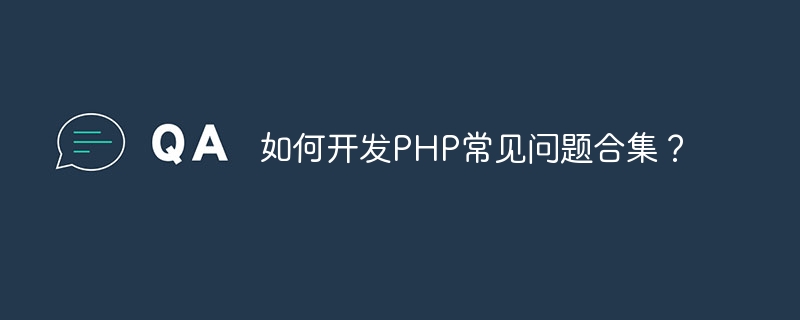

How to develop a collection of PHP FAQs?
With the rapid development and popularity of the Internet, PHP, as a bottom-level language, has become one of the preferred languages for developing web applications. What follows is the emergence of a series of common problems. In order to help PHP developers better understand and solve these problems, it has become a necessary task to develop a collection of PHP frequently asked questions. This article will introduce how to develop a collection of PHP frequently asked questions to help PHP developers better solve problems.
1. Determine the scope and target group of the collection
Before developing the PHP FAQ collection, you must first determine the scope and target group of the collection. The scope of the collection can be determined according to needs. For example, it can cover issues such as PHP syntax, frameworks, performance optimization, database operations, etc.; and the target group can be beginners, intermediate developers, or advanced developers. Based on the determination of the scope and target group, the content and structure of the collection can be better planned.
2. Collect frequently asked questions
After determining the scope of the collection and the target group, the next step is to collect frequently asked questions. Frequently asked questions can be collected through the following methods:
3. Sorting and classifying questions
After collecting common questions, it is necessary to sort and classify them. Questions can be classified according to their subject matter, difficulty level, technical level and other factors to facilitate readers' search and understanding. At the same time, you can also add corresponding tags to each question to facilitate readers to quickly locate the issues they care about.
4. Write answers to questions and additional instructions
After sorting and classifying the questions, you need to write answers to the questions and additional instructions based on the actual situation. The answer to the question should be concise and to the point, able to resolve the reader's doubts; additional instructions can include detailed steps of the solution, sample code, precautions, etc.
5. Improve the structure and interface of the collection
While writing answers to questions and additional instructions, you should also consider the design of the structure and interface of the collection. The structure of the collection should be clear and easy to understand, with clear hierarchical relationships between issues. The design of the interface should be simple and beautiful, easy for readers to browse and interact with. You can consider using tree directories, search functions, jump links, etc. to increase the ease of use and practicality of the collection.
6. Optimize the use experience of Collection
The use experience of Collection is one of the important indicators to evaluate its quality. In order to improve the use experience of the collection, you can consider the following optimizations:
7. Promotion and publicity of the collection
After the collection is developed, promotion and publicity are still needed to attract more readers. It can be promoted through the following channels:
Summary
Developing a collection of PHP FAQs can help PHP developers better understand and solve common problems. Determining the scope and target group of the collection, collecting frequently asked questions, organizing and classifying questions, writing answers to questions and additional instructions, improving the structure and interface of the collection, optimizing the use experience of the collection, promoting and publicizing the collection are the keys to developing a collection of PHP frequently asked questions step. I hope this article can inspire and help PHP developers when developing a collection of PHP FAQs.
The above is the detailed content of How to develop a collection of PHP FAQs?. For more information, please follow other related articles on the PHP Chinese website!




